
The Enemies of Rome
Celts
A perennial enemy of Rome that cause her great concern were the Celts. They were active enemies of Rome for hundreds of years and, over time, their weapons and tactics certainly would have evolved. What is represented here is a generalized version of the early Celtic warrior,described as larger than the Roman soldier, fighting naked, armed with a long sword and shield, long blond hair flying in the wind. The Celts are usually described as charging wildly and ferociously, using their swords in a slashing rather than a stabbing motion. The three images below attempt to capture the spirit of the Celtic warrior.

The wild charge of the Celts is shown in the discussion about gaps in the formation on an earlier page (Gaps) . The Celts are depicted as pouring through the gaps freely because they did not fight in a tightly bound formation like the phalanx. The drawing below shows this.

The drawing below shows the Celts engaging the Romans in more detail. The drawing attempts to represent the different tactics of the two armies. The Romans are arranged in ranks and files, which, however, are becoming disorganized as the press of combat disrupts the tidy arrangements. The Romans preferred a stabbing type of attack. In contrast the Celts are shown running fiercely into battle, with no tactical formation. Their long swords are shown in a variety of slashing motions. The Celtic figures are larger than the Roman figures and are shown without armor or clothing.
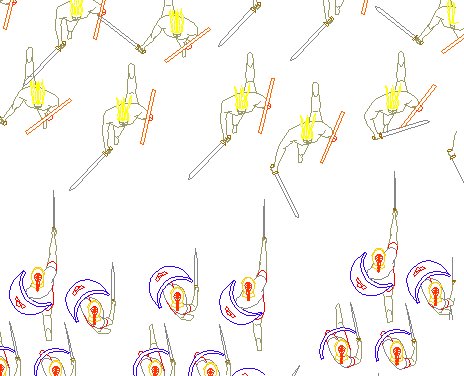
The Phalanx
Three variations on the phalanx are shown below. On the left is a Hoplite-type phalanx (red), in the center (green) is a mixed phalanx with spears and pikes, and on the right is a sarissa-type phalanx.
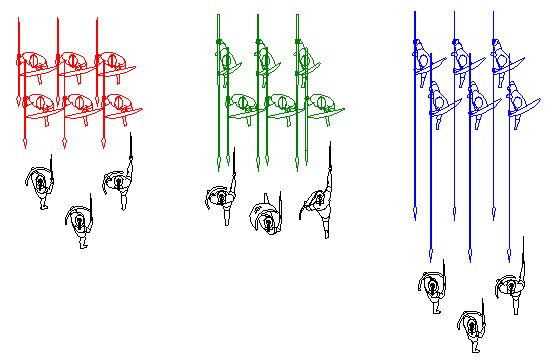
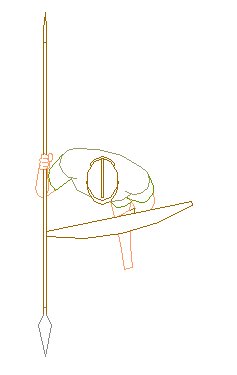
The Hoplite-type phalanx is a classic phalanx used by the Greeks and many other ancient armies. In it the soldiers are arranged in close ranks and files and are armed with a stabbing spear and shield. The figure at the left shows some of the characteristics of this soldier. The spear is 6''8" long and is held at about shoulder height. The shield represented here is round with a slight curvature.
The earliest Roman armies and the armies of the Italian tribes probably armed themselves and fought in the Hoplite fashion.

A typical depth for the phalanx was 8 ranks, though they actually appeared in a great variety of depths. The drawing at the left shows 8 ranks of the phalanx (top) arrayed against the more open Roman (bottom) battle order.
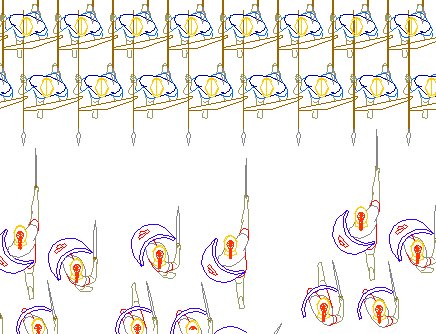
The drawing on the left is a close up of the one above to give an idea of the different weapons and tactics that would have been involved when the Roman soldier encountered the phalanx; sword against spear, mass against mobility.
The Phalanx
As the phalanx evolved longer spears and pikes came to be used. The key ingredient is the use of a long pike, or sarissa.
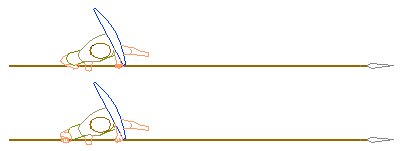
The two figures at the left show the different grips necessary when wielding the sarissa. A close inspection of the hands is necessary to see the difference; the image below makes the detail clearer.
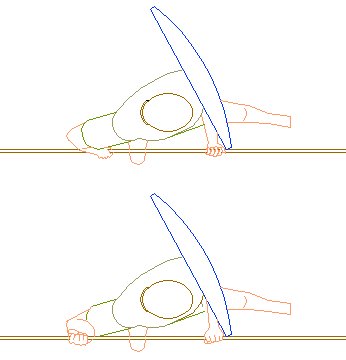
The front rank, depicted on the top, could hold the sarissa low, with his right elbow above the pike. His right hand grasps the sarissa palm down; his left, palm up. On both hands his thumbs are forward. This is a powerful hold, one that allows considerable leverage to be applied to the shaft.
The bottom figure is holding the sarissa at shoulder level. His right elbow is below the sarissa; on both hands the thumb is toward the rear. This is the grip that would be necessary for all ranks behind the first rank since the sarissa would have to be held high to clear the heads and shoulders of those in front. This would be an effective stabbing hold but would not provide the power or leverage of the lower grip.
Delbrück argues that not all of the sarissa's used by the phalanx were of the same length. In his view the first rank fought with a spear in the Hoplite manner. The following ranks wielded progressively longer sarissas so that all points came to about the same plane in front of the first ranks. The sarissas of the first 6 ranks are shown below.
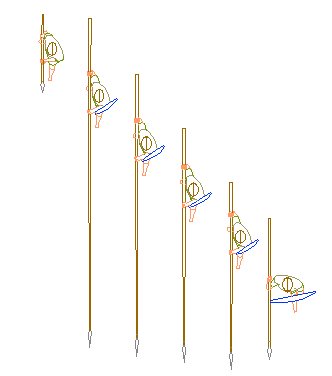
To the far left is the 6th rank. Since the sarissas from this rank would not project beyond the first rank they are held pointed up at an almost vertical angel. The sarissa for the 6th rank is shown foreshortened.
The sarissas of the first 5 ranks all project to about the same distance. They are 21', 18', 15' and 12' in length. The spears in the first rank are 9' long.
The drawing below shows how the formation would have looked. Each rank is colored to make them easier to distinguish.
 The hedge of 5
pike points per file would certainly have presented a formidable front.
The hedge of 5
pike points per file would certainly have presented a formidable front.
Each rank is slightly staggered so that the sarissa can project over the shoulder of the ranks in front. This works on paper but in practice the lines could not have been kept so neatly. Since the phalanx is always described as tightly compressed it would seem that the sarissas would have to have been pointed above the heads of the ranks in front. Were this the case they would not be particularly effective against the charging Romans who could easily slip under them.
The more traditional view is that all of the sarissas were the same length. In the drawing below this configuration is shown. The sarissas of the first 5 ranks project beyond the fist rank but not to the same plane. Again, as above, each rank is given a different color to make it easier to distinguish them.
The length of the sarissa, according to Delbrück, may have been up to 24' long or as short as 14'. The drawing below shows a 24' sarissa, held about 5' from the butt, and a 16' sarissa, held about 3' from the butt. The longer sarissa projects 15'6" in front, the shorter projects 11'. Some claim that the longer sarissas were weighted at the butt for balance, others say not. The sarissas represented here are not weighted.

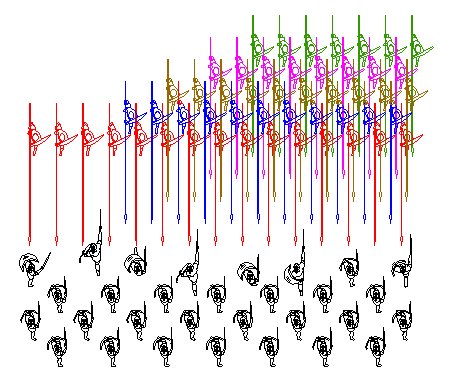 The same
concern expressed above about the sarissas clearing the heads of the ranks in front would
apply here.
The same
concern expressed above about the sarissas clearing the heads of the ranks in front would
apply here.
A major difference with this formation is that the first line of sarissa points occurs not 4' from the first rank, as above, but as much as 10' to 16', thus keeping the Romans well out of effective sword range. In the drawing to the left the sarissas of the first rank project 11'.
However they were held, the length of the sarissa would have made them difficult to maneuver. The butts projected behind, the shafts were either between the heads of the ranks in front or over their heads. Any large movement of the sarissa would have resulted in a collision either behind or in front.
John Warry, in Warfare in the Ancient World, shows the phalanx in a more open position in which the pikes of each rank have a clear field to the front. This formation is shown below. The difficulty with this solution is that the phalanx is always described as a tight formation, with only 1'6" to the file. This formation has as much as 4' between files.

